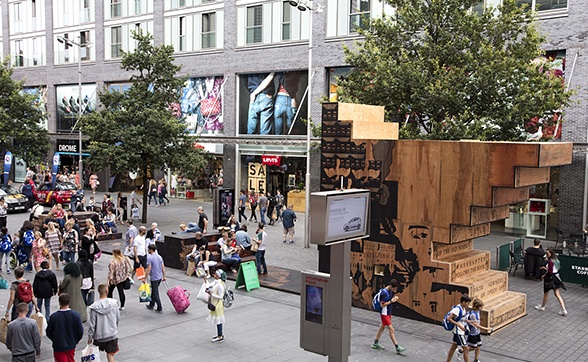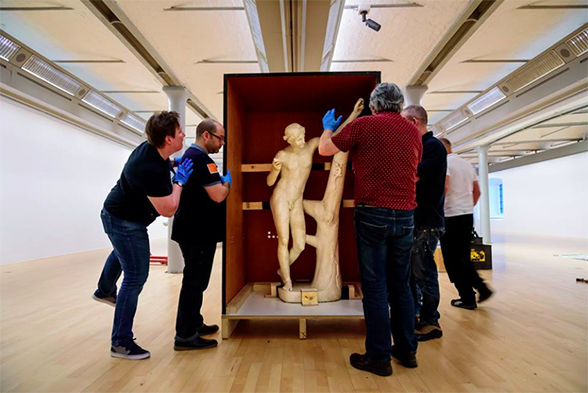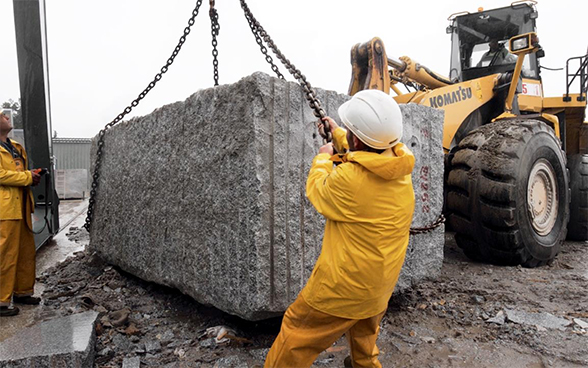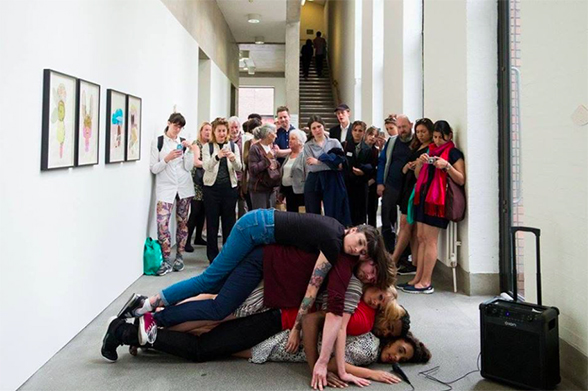Making a City-Wide Art Exhibition: 5 Things You Need to Know
Posted on 26 August 2016

Mariana Castillo Deball, To-day 9th of July 2016, 2016 in Liverpool ONE. Photo: Jerry Hardman-Jones
Mariana Castillo Deball, To-day 9th of July 2016, 2016 in Liverpool ONE. Photo: Jerry Hardman-Jones
Organising a city-wide art festival is no small feat. Two years in the making, Liverpool Biennial 2016 brings together 44 artists from across the world to present their work in the city’s art hubs, streets and lesser-known locations. But how do you go from concept to creation? To coincide with the release of our video about the making of this year's festival, here we've put together five things you need to know about making a contemporary art festival.
1. Develop an idea and invite artists
Begin by assembling a team of curators to discuss different artists and ideas. For the Biennial, a great deal of these conversations were had whilst wandering the city and speaking to its people: taking inspiration from Liverpool’s architecture and stories from its past, present and imagined future. A concept or framework for the exhibition was then developed. Inspired by the TV series format, we chose to structure the festival around episodes, each a parallel world that relates to a different aspect of Liverpool, such as its Chinatown or Ancient Greek influence. As soon as the artists are invited into the process, their ideas and insights will help shape the concept further, bringing forth new experiences and visions of the city.

Seeking inspiration in the architecture of The Black-E and Chinese Arch. Photo: Shirlaine Forrest / Getty
Members of the community were also involved in Liverpool Biennial 2016. For example, Marvin Gaye Chetwynd’s Dogsy Ma Bone was made in collaboration with 78 local children, while original participants of the 1985 Liverpool School Students’ Strike played a key role in helping Koki Tanaka to restage the historic event.
2. Start looking for venues
The next thing is to start searching for suitable spaces where art can be presented or created. For Biennial 2016, this process was led by the idea of storytelling and the themes behind each of the episodes. We worked closely in collaboration with the city’s key galleries and museums, including Tate Liverpool, FACT, Open Eye, Bluecoat and Walker Art Gallery. Unusual, rarely accessible locations such as Liverpool’s iconic former ABC Cinema and the Victorian Toxteth Reservoir were exciting opportunities for the display of new artworks. Other places need to be chosen by individual artists based on their very specific set of concerns. One such example is Derby Square where Lawrence Abu Hamdan’s Hummingbird Clock now keeps a watchful eye over Liverpool’s town hall, or Alisa Baremboym’s Locus of Control in Granby, which uses the same perforated sheet steel as the shutters of nearby houses. We also asked for people's own suggestions and received an incredible response.

The filming of Marvin Gaye Chetwynd's Dogsy Ma Bone, 2016. Photo by Pete Carr
The process of finding a space is challenging! It often involves a long and complex process of negotiation, either with the city’s authorities or private landlords, before a space can be secured. Visitor safety is another essential consideration: you may have found a fantastic space but people need to be able to get in.
3. Tell everyone about it!
There’s no point staging a festival or art exhibition if no one knows about it. Building people’s awareness of the Biennial and what it has to offer is a non-stop process. Art is for everyone, so it’s important to tell stories in multiple ways to capture different people’s attention – from art aficionados and tourists, to families and casual passers-by. Building relationships with journalists from a whole range of different local, national and international publications is important. And so is getting creative online and using social media to build excitement by sharing exciting behind-the-scenes content, artist interviews, trailers or live-streaming events so that they can be experienced by anyone around the world.

Hondo Chinese Supermarket, where Ian Cheng's 'Something Thinking of You' can be found. Photo: Mark McNulty
Remember to also think carefully about your visitors’ experience. We produced a guide and map to help people navigate between each of the festival’s 22 locations and provide insight into each of the exhibitions. Creating a special experience for children and families is important: Banjo and the Portal Adventures is a short story in which readers are invited to join Banjo the cat on a journey across the city. Finally, you want people to recognise your festival and its different locations so develop a strong visual identity and use this consistently across all that you do.
4. Install the works and assemble a great team
After all the planning and preparation comes the time to install. This included moving Lara Favaretto's 24-tonne stone which began its journey in a French quarry and was shipped to Ireland to be cut before arriving in Liverpool. In the majority of cases, however, artists create their commissions on-site in the run-up to the opening. It’s always a very busy and hectic process, which is why it’s important to have a brilliant team. Our curatorial assistants, technicians, trainees, festival mediators and volunteers (the people on the ground who help ensure everything is running smoothly and guide visitors through their visit) all played a key role: donning hard hats, painting gallery walls and working around the clock with artists on their commissions.

Art handlers install the Statue of Apollo Sauroktonos © Tate Liverpool, Roger Sinek

Transporting Lara Favaretto's Momentary Monument – The Stone
5. Invite the world over to celebrate the opening
After all the hard work, make sure to open with a bang! Fill your opening day (or weekend) with a packed public programme of performances, tours and workshops to mark the exhibition’s launch, plus a huge party to celebrate with the artists, the city and everyone who has played a part in making it all happen.

Bloomberg New Contemporaries exhibition opening at Bluecoat. Photo: Mark McNulty

Michael Portnoy, Relational Stalinism – The Musical, 2016. Photo: Rob Battersby
Liverpool Biennial 2016 exhibitions are free and open daily in venues and public spaces across the city until 16 October.
Liverpool Biennial
55 New Bird Street
Liverpool L1 0BW
- T +44 (0)151 709 7444
- info@biennial.com
Liverpool Biennial is funded by
Founding Supporter
James Moores